Waldwandel / Forest Flux
Augmented reality art, Tamiko Thiel and /p, 2023
DEUTSCH
Until 14 Sept. 2025 @ Chiostro del Bramante, Rome, in the exhibition:
"FLOWERS. Art from the Renaissance to Augmented Reality"
The exhibition "Flowers Forever" travels to Rome, and includes Waldwandel/Forest Flux as a wall-sized AR livestream projection!

Waldwandel/Forest Flux large AR livestream projection (wild service tree / rose chafer beetles scene).
"FLOWERS. Art from the Renaissance to Augmented Reality," Chiostro del Bramante, Rome, Italy.
"FLOWERS. Art from the Renaissance to Augmented Reality," Chiostro del Bramante, Rome, Italy.
Commissioned by the Kunsthalle Munich in collaboration with the Bavarian State Forest Enterprise* and the Museum of Natural History Bavaria/Biotopia Lab, Waldwandel / Forest Flux provides an immersive encounter with how climate change is affecting the Bavarian forests. As soon as they enter the room, visitors see themselves inside the virtual forest, in a large AR livestream projection. Additionally they can view the AR installation surrounding them in 360° on dedicated iPads that they can take in their hands, and through the free ARpoise app that they can download onto their own smartphones.
Musical Improvisation for Waldwandel/Forest Flux
On 18 October 2025, at the kind invitation of Julia Maier, we had the honor of participating in the "Wald im Wandel" ("The Changing Forest") concert, in Burg Schwaneck near Munich, organized by her and other members of the Muenchner Symphoniker / Orchester des Wandels.
Mattias Krön on alphorn and Olivia Neuhauser on harp graciously developed a poignant musical improvisation for Waldwandel/Forest Flux, which joined them on stage as an AR livestream projection.
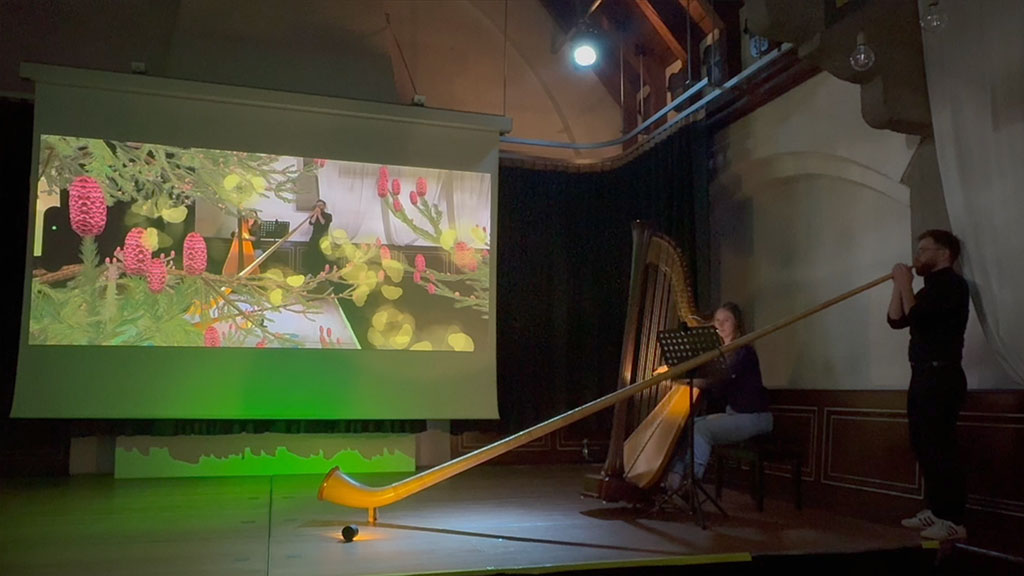
Concert view of Waldwandel/Forest Flux large AR livestream projection, with Mattias Kroen on alphorn and Olivia Neuhauser on harp. Photo: Julia Maier, Muenchner Symphoniker/Orchester des Wandels.
"Waldwandel/Forest Flux" AR livestream with Mattias Kroen/Alphorn and Olivia Neuhauser/Harp.
We were thrilled that Martin Janner, 2023 Forest Ranger of the Year, came all the way from his revier at the mythic Lorelei on the Rhine River to regale us with stories of how not only the German forests changed over time, but how also the cultural meaning of the forest in Germany changed over the 200 years covered by the concert, from Robert Schumann to Mattias and Olivia's new improvisation.
Martin's fascinating insights into Waldwandel, and to Mattias' and Olivia's music and wooden instruments is in German - perhaps AI can help those who don't understand the original?
Wer sich für das Thema interessiert und Deutsch kann soll auf jeden Fall sein Buch "Der Wald der Zukunft" und die viele Interviews lesen und die Videos über Martin anschauen!
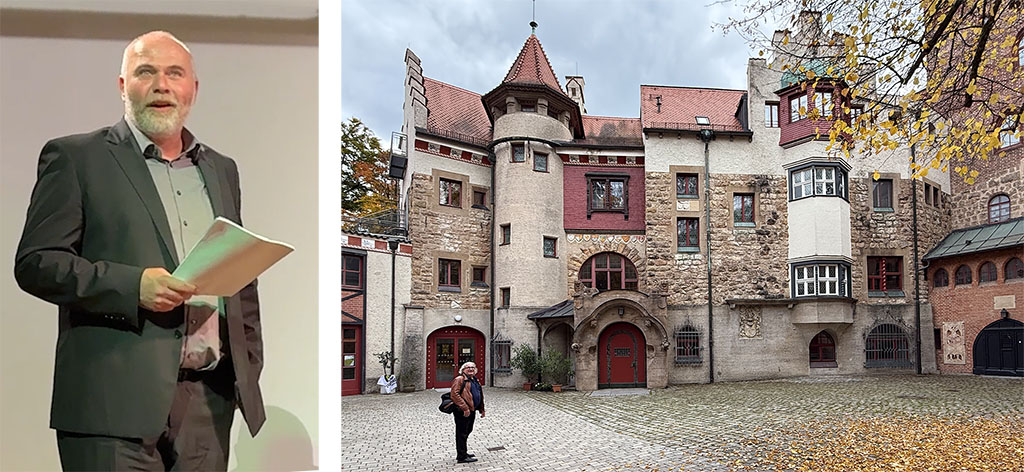
Left: Martin Janner, "2023 Forest Ranger of the Year." Right: Burg Schwaneck, a 19th century fantasy castle in Pullach near Munich, now a nature educational center and youth hostel.
PAST: 4 large billboards are image triggers for Wandwandel AR installation.
The most stunning location we have had yet for our AR art in public space has to be the Belval district of Esch-sur-Alzette. A former steel mill preserved as an industrial monument, our billboards stood between two huge blast furnaces, and our virtual foliage provided a marked contrast to these monuments.
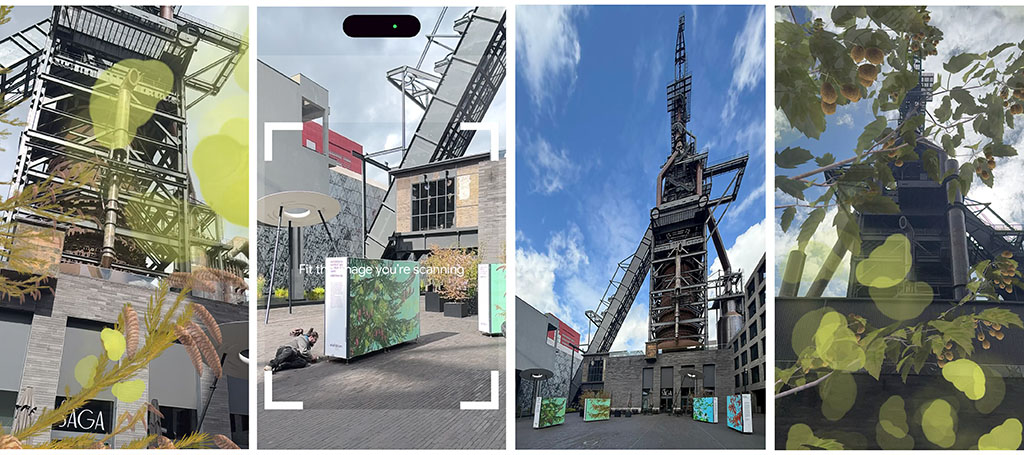
Waldwandel/Forest Flux in Belval, the university district of Esch-sur-Alzette.
Elektron Luxembourg showed the work in their exhibit "Hybrid Futures" in various places in Esch-sur-Alzette, Luxembourg. Visitors downloaded our ARpoise AR app and then scanned the images with their own smartphones, to find themselves immersed in a virtual forest glade.
Waldwandel/Forest Flux. Outdoor image trigger AR installation in the exhibit "Hybrid Futures," Place Boltgen, Esch-sur-Alzette, Luxembourg. Curated and produced by Elektron Luxembourg, 2025.
BACKGROUND:
For the Norway Spruce (Fichte, Picea abies), long a staple of the Bavarian forest economy, abundant conical blossoms (actually "strobili," a sort of proto-flower) and the resultant clouds of wind-borne pollen are probably a form of survival instinct, as the trees attempt to survive the dryer, hotter environment we have created.
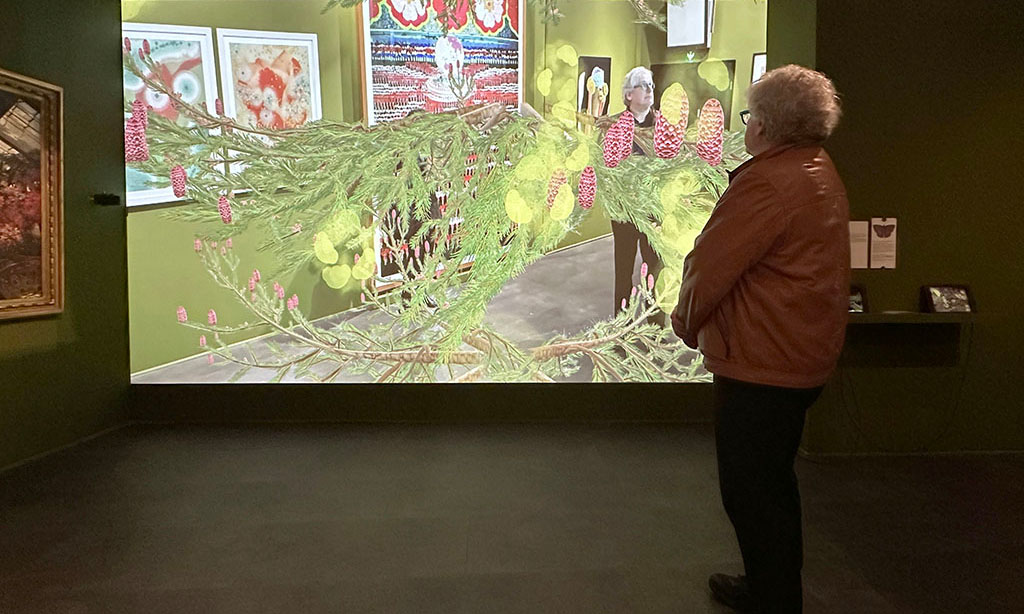
Waldwandel/Forest Flux large AR livestream projection (spruce pollination scene).
"FLOWERS. Art from the Renaissance to Augmented Reality," Chiostro del Bramante, Rome, Italy.
"FLOWERS. Art from the Renaissance to Augmented Reality," Chiostro del Bramante, Rome, Italy.
Foresters are now fostering other native tree species that will form the Bavarian "climate forest" of the future (Klimawald). These include well known species like oak (Eiche), beech (Buche) and fir (the Tannenbaum of the famous Christmas song).
One of the lesser known native trees, featured in this artwork, is the "Chequers Tree" or "Wild Service Tree" (Elsbeere, Sorbus torminalis). Its valuable hardwood was used for things like musical instruments, billiard cue sticks, measuring instruments and for decorative inlay. In Britain it is long associated with "Chequers Inns" that served an alcoholic drink made from its fruits, in fact the name "service tree" derives from the Latin "cervisia" (Spanish "cerveza" = beer). The chequers tree is predicted to thrive under the coming climate conditions; its abundant flowers will attract and feed pollenators, and its fruits provide sustenance for many other forest denizens.
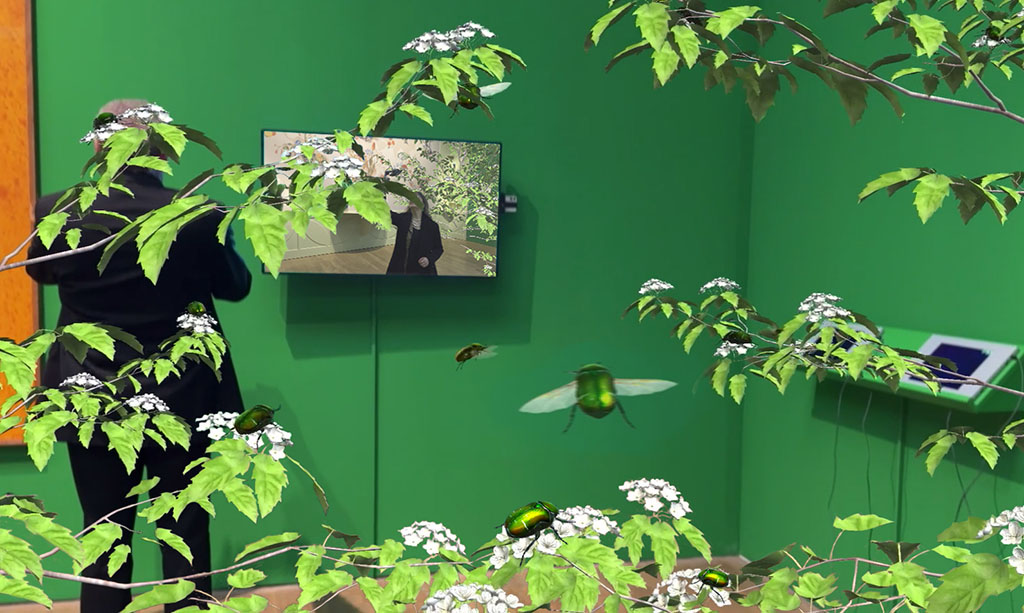
Waldwandel/Forest Flux: wild service tree (chequers tree) with rose chafer beetles. In the exhibit "Flower Forever," Kunsthalle Munich, 2023.
The artwork also focuses on a less known pollenator of the chequers blossoms: the brilliant green rose chafer beetle (Rosenkaefer, Cetonia aurata). Besides pollinating they break down compost and decaying wood. The fad for keeping honey bees is endangering wild bees, especially in the USA where they are not native. There are also many other types of pollinating insects (beetles, flies, butterflies, moths, wasps, etc.) that often service ecological niches that bees cannot, and that play additional important roles in the health of natural ecosystems.
Waldwandel/Forest Flux. Walkthrough of the AR installation in the exhibit "Flowers Forever," Kunsthalle Munich, 2023.
Waldwandel / Forest Flux was commissioned by the Kunsthalle Munich for the exhibit "Flowers Forever" (curated by Franziska Stöhr), Museum of Natural History Bavaria/Biotopia Lab, and the Bavarian State Forest Enterprise. Sponsored by generous grants from the Bavarian State Forest Enterprise, and from Sundance Institute Interdisciplinary Program with support from Unity Charitable Fund/Tides Foundation.
Thanks to Skylla and Lametta for the 3D plant modeling, and to spec.studio for the 3D insect modeling and animation! * The Bavarian State Forest Enterprise, with some 2400 staff members, manages the approximately 805,000 hectares of the Bavarian State Forest. Our overriding principle is sustainability, in which we only harvest as much wood as we plant. We are converting the Bavarian State Forest from the spruce monoculture of the past into a sustainable, climate change tolerant, species-rich mixed forest - we are designing the Klimawald, the climate change resilient forest of the future. In this way, we are also creating and securing habitats for many species, thus increasing biodiversity. Our forests also store drinking water, produce clean air, protect against avalanches and are an invaluable place for people to relax and rejuvenate both mind and body.